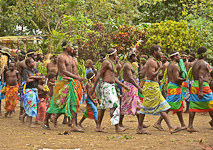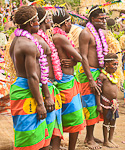General information about Vanuatu
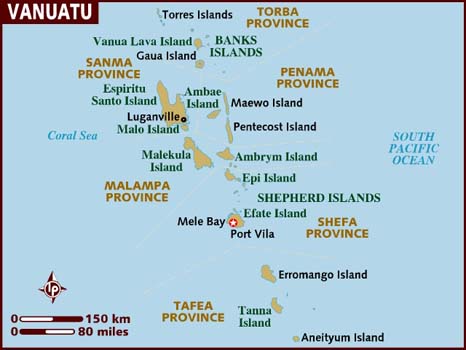
Vanuatu is a Y-shaped tropical archipelago of over eighty islands, sixty-five of which are inhabited. The Solomon Islands lie to the north, New Caledonia to the south, Fiji to the east, and the Coral Sea and Australia to the west. The mostly volcanic archipelago extends 560 miles (900 kilometers) from north to south and has an area of 5,700 square miles (14,760 square kilometers). Espiritu Santo is the largest island. Port Vila, the capital, which was also the colonial headquarters, is on the south-central island of Efate. The ni-Vanuatu people are predominantly Melanesian and have more than 110 distinctly different cultures and languages. The total population is about 200,000. Bislama, French and English are the three national languages.
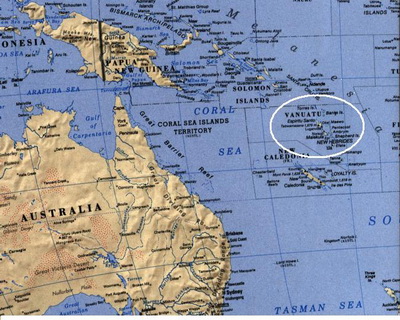
The first people arrived in Vanuatu about 4000 years ago. Pottery fragments have been dated to 1300-1100 BC. The first island to be discovered by Europeans was Espiritu Santo in 1606 by the Portuguese explorer, Pedro Fernandez De Quiros. No Europeans returned until Louis Antoine de Bougainville rediscovered the islands in 1768. In 1774 Captain Cook visited, drew the first charts of the islands and named the islands the New Hebrides. The name lasted until independence in 1980 when it was changed to Vanuatu.
The name "Vanuatu" is an important aspect of national identity. Leaders of the Vanua'aku Party, which led the first independent government, invented the term in 1980 to replace the colonial name New Hebrides. Vanua means "land" in many of Vanuatu's one hundred five languages, and translations of the new name include "Our Land" and "Abiding Land." Culturally, Vanuatu is complex.
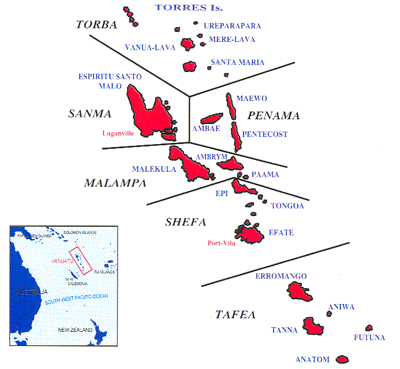
The country of Vanuatu is divided into 6 provinces. Tafea is the southernmost province and the name is made from the first letters of the five islands: Tanna, Aneityum, Futuna, Erromango and Aniwa.
The worldwide Responsible Tourism Partnership publishes a list of guidelines for travel in the Pacific islands:
1. Learn aboout the country and its culture. Remember that each country in the Pacific is inique. Be aware of local religions and social customs. Dress and behave respectfully especially in villages, religious and cultural areas. Learn key words in the local language. Respect the dignity and privacy of others - ask before taking photos.
2. Minimise environmental impact. Dispose of rubbish carefully, recycle where possible, reuse your drink bottles and shopping bags. Minimise water and energy use. Choose environmentally tour operators.
3. Protect the coral. Do not buy products made from coral, endangered plants or animals. Do not stand on, touch or remove any items from the reef, including coral.
4. Support local initiatives. Purchase local products, arts and crafts. Eat local rather then imported food. Support local tour operators and stay at locally owned accomodations. If you want to give money, support community projects rather than individuals.
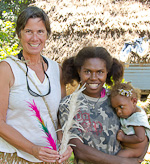 5. Pay a fair price. Bargaining for goods is not culturally acceptable in Vanuatu. If the price is negotiable, pay a price that is fair to the seller and maker.
5. Pay a fair price. Bargaining for goods is not culturally acceptable in Vanuatu. If the price is negotiable, pay a price that is fair to the seller and maker.
6. Think about your impact. Remember you are a guest - always behave respectfully. Make your trip a positive experience for both you and the people in the country you visit.
Village Repect
Stick to the road when passing through villages. If you would like to enter a village wait on the outskirts until someone approaches you.
Most land is owned by the villagers and their families.
Do not pick fruit or vegtables along the roads and trails. This belongs to someone.
Swim suits, shorts, sleeveless tops on women and other skimpy clothes are considered disrespectful in villages. Vistors shoulld be fully dressed.
With the exception of Port Vila, kava is usually drunk only by men. Often it is acceptable for women travelers to try kava, but the men's meeting area, the Nakimal, is for men only.
Ask about and observe local tabu areas.
Because of the importance of the volcano to the tourism industry in Tanna, the local government has created levels to restrict people's access:
Level 0 - Low activity, access to the crater allowed; Level 1 - Normal activity, access to the crater allowed; Level 2 - Moderate to high activity, lava bombs may land beyond the crater rim, access to the crater is closed; Level 3 - Severe activity with loud explosions, lava bombs ejected up to hundreds of metres outside the crater and large plumes of smoke and ash, access to the summit zone is closed; Level 4 - Major eruption affecting large areas around the volcano and possibly other parts of Tanna and even neighbouring islands, all access closed.
plumes of smoke and ash, access to the summit zone is closed; Level 4 - Major eruption affecting large areas around the volcano and possibly other parts of Tanna and even neighbouring islands, all access closed.

